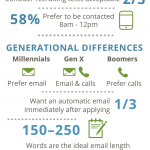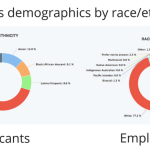Four Unique Ways These Companies Are Finding The Best Job Candidates
Hiring is a lot like dating: Both parties are often on their best behavior during the interview process, and you often don’t know if the candidate and company are a good match until several months later. Unfortunately that can cost an employer time and money.
More than half of voluntary turnover happens within a year of new hires’ start dates, according to a study by Equifax, and replacing that person can cost as much as 60% of their annual salary, according to research from the Society for Human Resource Management.
These companies have found a better way to screen candidates to find those who are a good fit and who will stick around.
Holding Wine And Cheese Parties
Job candidates at the staffing company Creative Niche go through two rounds of interviews. If they’re deemed to be a good fit, they’re invited to the third and final step, a wine and cheese party with the staff. Going to the party is voluntary for current employees, but most attend, says CEO Mandy Gilbert. When it’s done and the candidate leaves, the group gives the person a thumbs up or down. It has to be unanimous in order for the candidate to get a job offer.
The strategy has boosted the company’s retention rate to 90%. “The idea came from having some bad cultural hires,” Gilbert says. “I tend to be a quick mover, and I needed to slow down the pace and bring more insight and more perspective,” she admits. “The wine and cheese party makes my team aligned and excited,” she says.
Gilbert doesn’t attend the party, she gives her team the final say. “Having the team hire is more powerful because they tend to have the bandwidth to spend enough time to get to the details of what motivates the candidate and how they handle stress.”
As a recruiting firm, part of the hiring criteria is finding someone who can feel comfortable talking to others and digging deep, says Gilbert. “Being in this situation shows us if you’re able to ask questions and have conversations with various people,” she says. “We’ve had about 90% of candidates pass the wine and cheese party test, and we’ve also avoided making some bad hires.”
Ditching Resumes
If you want to get a job at the tech firm Detroit Labs, don’t send a resume. The company has candidates fill out a Getting to Know You (GTKY) document instead. The form has a variety of questions, ranging from personal information about hobbies to technical questions. For example, applicants are asked to share the titles of some books on their bookshelf or Kindle, the name of their favorite blogger, and the last new skill they learned. The answers are distributed to all current employees who are invited to share their thoughts.
“The GTKY is designed to replace the filler we often see in resumes with the kind of information we really want to use to determine if a candidate should come in for an in-person interview,” says cofounder Nathan Hughes. “We hope they tell us if the candidate has the aptitude for the job, the motivation to succeed in our environment, and the willingness to put in the effort and energy during this early stage to tell us their story and get us interested.”
The last question on the form is Hughes’s favorite: “Fill in a question you really wanted me to ask, that question you most want to answer.”
“We want the candidate to present to us a knock-it-out-of-the-park question that they have an amazing answer for,” he says. “Sometimes people completely waste the opportunity with a ‘Why should Labs hire you for this job? I’m the best!’ submission,” Hughes explains. “But other times people really open up and let us see something important and meaningful about themselves,” he says. “It’s probably the single most influential question overall.”
Hughes has been using the form for the past five years and says he’s found correlations between answers and culture fit. “We are able to see patterns in the answers, the ways certain candidates answer certain questions, and how that plays out in the job over time,” he says. “We use that information to better assess and predict a candidate’s potential.”
Watching Outside Behavior
Job candidates at Zappos may not realize it, but part of the company’s interview process happens outside of their corporate offices. If the applicant isn’t local, Zappos sends a car to pick them up and take them from the airport to the company’s Las Vegas headquarters. During the ride, the driver is watching and taking notes.
“One of our core values is to be humble, and another one is about family spirit, so if they aren’t nice to the shuttle driver . . . it’s in violation of those values,” Hsieh said in an interview at a recent Wharton People Analytics Conference. It doesn’t matter how well the interviews went, if the shuttle driver wasn’t treated well, the person is not hired.
Using Hiring Auditions
Instead of vetting and interviewing job candidates one by one, software firm Menlo Innovations holds mass auditions that mimic the company’s day-to-day operations, helping leaders find candidates who would be a good fit.
“Our staff spends their days working in pairs, with each pair collaborating on a distinct task, sharing a single computer,” CEO Richard Sheridan wrote in an article for Inc.com. “So when applicants show up for our auditions, we pair them up and give each pair a single sheet of paper and a pencil.”
The two are asked to work together to complete a task, but they’re told that the goal is to make their partner look good enough to be invited back to the next step. “We want good kindergarten skills at Menlo, and we test for them from the very beginning,” writes Sheridan. “An existing employee observes and takes notes on each pair while it collaborates on a task typical of the company’s work. They look for specific evidence of authentic collaboration, confidence, and humility.”
After the applicants leave, the staff share what they’ve observed. Three thumbs up gets you to the next stage; three thumbs down gets you a polite rejection. Menlo Innovations has boosted retention by giving candidates a trial run. “Customize your hiring process to test for cultural fit and give applicants a realistic sense of whether they’ll be happy and effective working for you,” writes Sheridan.
Fast Company , Read Full Story
(31)













